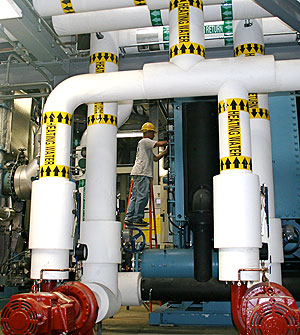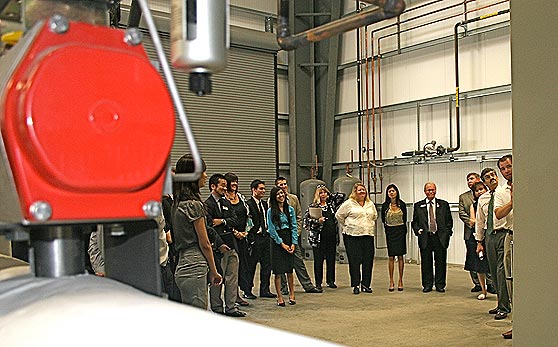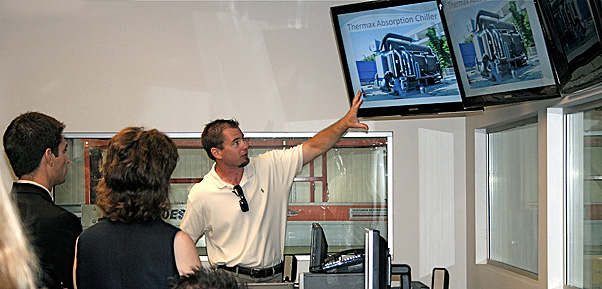Greener Power
New Central Plant Becomes Operational
July 20, 2010
By Pamela McLaren

Sam Lee of Thermax Inc, inspects a chiller in the trigeneration plant. Photo by Mimi Ko Cruz
When the university’s new trigeneration plant begins operating next month, few will realize that a change has occurred — but its effect will be massive.
For the first time, the campus will be creating roughly half of all the power it uses — in a manner that is environmentally friendly, saves money and offers flexibility to continue to meet the university’s demands for heating, cooling and electrical needs.
“We wanted to build a system that was effective, flexible enough that we could use various energy sources and had room to grow,” explained Jim Corbett, assistant director of programs and projects in physical plant. “Our approach became to build a plant that could generate its own power, lessening our dependence on off-campus sources, as well as at the same time, produce heating and cooling for the campus.”
“Our previous system — built in 1992 and all electric — worked well and at the time of its construction was clean and cost efficient,” said Jeff Bechtold, building technology specialist in physical plant, during a recent tour of the 8,000 square foot facility located south of the Clayes Performing Arts Center and east of the Nutwood Parking Structure. “But with new buildings, more people and more demands, it couldn’t continue to work alone.
“And yet, we certainly haven’t put it out to pasture,” added Bechtold, noting that besides the electric chillers, the cooling towers at the substation and the hot and cold water thermal energy storage tanks form the old central plant infrastructure have been incorporated into the new plant.
The new trigeneration plant will provide energy through three means: high-pressure natural gas will power a 4.6 mega-watt turbine to generate electricity. In turn, waste heat created by the turbine will be distributed to boilers to heat water and via two 1,310-ton absorption chillers generate cool water — which then can be used to heat and cool the campus and provide hot tap water.
“Rather than use a chemical refrigerant in the system, we’ll be using water, a much cleaner, more environmentally safe means,” said Bechtold. “The turbine that we have is known as one of the lowest emission engines available.
When fully online, the new plant will generate enough power to supply 4,000 homes, he said.
"We’ll be operating 24 hours a day, seven days a week, 365 days a year,” Bechtold added. “And, we’re not stopping there, we’ll continue to watch for opportunities to bring greater efficiency to the system to not only save money but to do our fair share in keeping the environment clean.”

Jeff Bechtold, far right, leads a tour inside the trigeneration plant. Photo by Mimi Ko Cruz
Related Stories:
Green Partnership
What is Sustainability?
Campus Taskes Part in “Flex Your Power” Energy Demand Program
Cal State Fullerton Goes Green With Energy Efficiency, Building Design
Student Recreation Center Receives ‘Best Overall Sustainable Design’ Award


